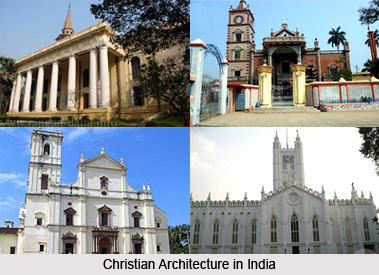 Christian Sculpture and architecture arrived in the sub continent with the emergence of the British Raj. The colonial architecture soon gathered momentum and a number of monuments were constructed by following a new style: Indo Saracenic. In fact the Indian churches have been built by following this Indian school of architecture. However it would be wrong to deduce that the Christian sculptures and architecture only followed the British style.
Christian Sculpture and architecture arrived in the sub continent with the emergence of the British Raj. The colonial architecture soon gathered momentum and a number of monuments were constructed by following a new style: Indo Saracenic. In fact the Indian churches have been built by following this Indian school of architecture. However it would be wrong to deduce that the Christian sculptures and architecture only followed the British style.
The colonial architecture in India also reveals the impact of the Dutch visitors. Especially, down south, the religious monuments have been consecrated by following the Portuguese idiom. The Indian religious sculptures that followed the colonial vocabulary had a number of similarities with the Gothic style of architecture that evolved in Europe. The churches were adorned with the remarkable wooden sculptures at the altars. These sculptures essentially reflected the Indo-Christian style.
The Christian sculptures of the following monuments offer a more comprehensive notion about the Christian art and architecture that developed in India:
| Basilica of Bom Jesus, Panaji | Malayatoor Church, Kochi | Christ Church, Lucknow |
| Se Cathedral, Panaji | St. Mary`s Valiyapally, Kottayam | All Saints Cathedral, Allahabad |
| Gundala Church, Vijayawada | Santa Cruz Basillica, Kochi | Parumala Church, Tiruvallur |
| Medak Church, Medak | St. Francis Church, Kochi | St.Mary`s Church (Manarkad), Kottayam |
| St. Joseph`s Cathedral, Hyderabad | Afghan Memorial Church, Mumbai | St.George Church (Puthupally), Kottayam |
| St. Mary`s Church, Hyderabad | Cathedral Church of St. Thomas, Mumbai | St.Mary`s Church (Niranam), Tiruvallur |
| Church of the Sacred Heart, New Delhi | Holy Christ Church, Mahabaleshwar | St. Mary`s Church (Bharananganam), Kottayam |
| Cathedral Church of the Redemption, New Delhi | Mount Mary Church, Mumbai | St.George Church (Kadamattom), Ernakulam |
| The Chapel of Our Lady of The Mount, Panaji | Christ The King Church, Chennai | St. George Church (Edappally), Ernakulam |
| Chapel of St. Catherine, Panaji | Luz Church, Chennai | St. Ignatius Church (Manjinikkara), Pathanamthitta |
| Church and Convent of St. Monica, Panaji | Kandal Cross Shrine, Udagamandalam | St. George Church (Edathala), Tiruvallur |
| Church of Our Lady of The Rosary, Panaji | San Thome Cathedral Basilica, Chennai | Bandel Church, Kolkata |
| Church of St. Cajetan, Panaji | St. Andrew`s Church, Chennai | St. Mary`s Church (Kalloopara), Tiruvallur |
| Church of St. Francis of Assisi, Panaji | St. Mary`s Church, Chennai | St. John`s Church, Bengaluru |
| Church of St. Francis Xavier, Panaji | Velankanni Church, Nagapattinam | St. Mary`s Basilica, Bengaluru |
| Church of The Carmelites, Panaji | St. Peter`s Church, Allahabad | St. Mark`s Cathedral, Bengaluru |
| Church of St John of God, Panaji | St. Joseph`s Church, Gorakhpur | St. Bartholomew`s Church, Mysore |
| Church of The Cross Of Miracles, Panaji | St. Joseph`s Church, Allahabad | All Saints Church, Bengaluru |
| Royal Chapel of St. Anthony, Panaji | St. John`s Church, Meerut | St. Thomas Ecumenical Church, Pathanamthitta |
| Christ Church and St Michael`s Cathedral, Shimla | St. George`s Church, Agra | Mar Gregorios Orthodox Church, New Delhi |
| The Christ Church, Kasauli | Sardhana Church, Meerut | Christ Church, Noida |
| St. Francis Church, Dalhousie | Kanpur Memorial Church, Kanpur | Our Lady of Snows Basilica, Tuticorin |
| St. John`s Church in Wilderness, Dharamshala | Jamuna Church, Allahabad | St. Thomas Orthodox (Valiyapally Ranni), Pathanamthitta |
| St. Philomena`s Church, Mysore | Holy Trinity Church, Allahabad | Centenary Baptist Church, Warangal |



















